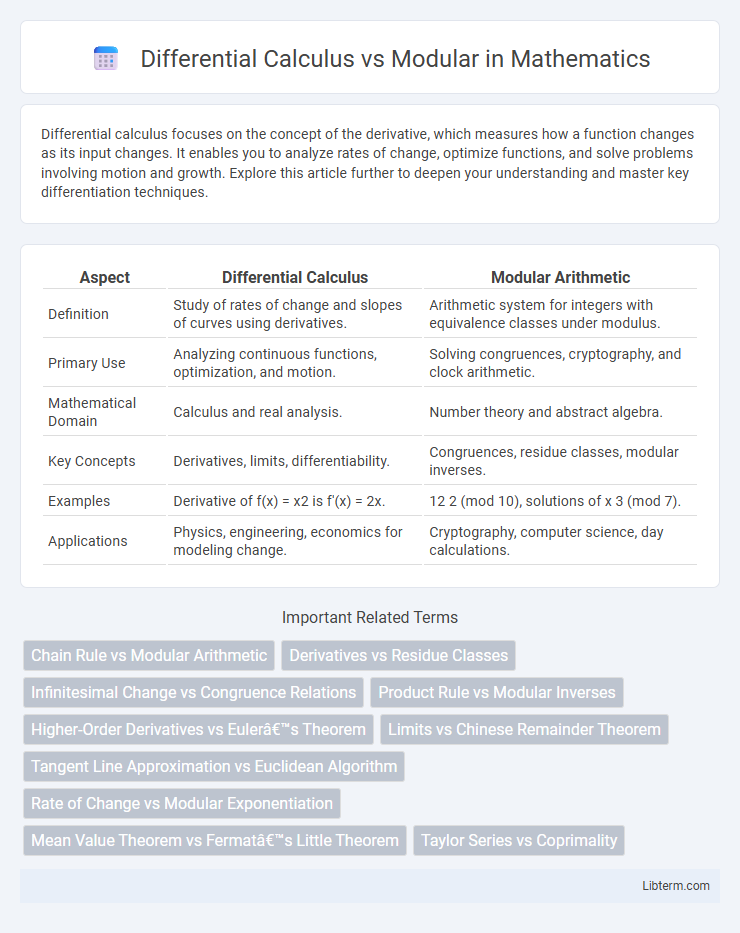Differential calculus focuses on the concept of the derivative, which measures how a function changes as its input changes. It enables you to analyze rates of change, optimize functions, and solve problems involving motion and growth. Explore this article further to deepen your understanding and master key differentiation techniques.
Table of Comparison
| Aspect | Differential Calculus | Modular Arithmetic |
|---|---|---|
| Definition | Study of rates of change and slopes of curves using derivatives. | Arithmetic system for integers with equivalence classes under modulus. |
| Primary Use | Analyzing continuous functions, optimization, and motion. | Solving congruences, cryptography, and clock arithmetic. |
| Mathematical Domain | Calculus and real analysis. | Number theory and abstract algebra. |
| Key Concepts | Derivatives, limits, differentiability. | Congruences, residue classes, modular inverses. |
| Examples | Derivative of f(x) = x2 is f'(x) = 2x. | 12 2 (mod 10), solutions of x 3 (mod 7). |
| Applications | Physics, engineering, economics for modeling change. | Cryptography, computer science, day calculations. |
Introduction to Differential Calculus and Modular Mathematics
Differential calculus explores rates of change and slopes of curves, fundamental for analyzing continuous functions and understanding motion, growth, and optimization. Modular mathematics deals with arithmetic concerning integers within a fixed modulus, essential for encryption, coding theory, and number theory applications. Both fields offer foundational tools in advanced mathematics but focus on distinct concepts: continuous change in differential calculus versus discrete structures in modular mathematics.
Historical Development of Differential Calculus
Differential calculus originated in the late 17th century through the independent work of Isaac Newton and Gottfried Wilhelm Leibniz, who developed foundational concepts such as derivatives and differentials to analyze changing quantities. Its historical development paved the way for modern calculus, forming the basis for mathematical physics, engineering, and dynamic systems. Unlike modular arithmetic, which evolved from number theory studies on congruences and remainders by Carl Friedrich Gauss in the 19th century, differential calculus remains central to continuous change analysis in scientific disciplines.
Origins and Evolution of Modular Arithmetic
Differential calculus originated in the 17th century with Isaac Newton and Gottfried Wilhelm Leibniz, revolutionizing the study of change and motion through derivatives. Modular arithmetic, developed by Carl Friedrich Gauss in his 1801 work *Disquisitiones Arithmeticae*, evolved as a foundational system in number theory for analyzing congruences and cyclical properties of integers. While differential calculus underpins continuous mathematics, modular arithmetic's discrete structure has become essential in cryptography, computer science, and abstract algebra.
Fundamental Concepts in Differential Calculus
Differential calculus centers on the concept of the derivative, which measures the instantaneous rate of change of a function with respect to its variable, forming the foundation for analyzing slopes of curves and optimization problems. Key entities include limits, continuity, and differentiability, allowing the precise calculation of tangent lines and rates of change. Modular arithmetic, in contrast, deals with integers within a residue system defined by a modulus n, focusing on equivalence classes and operations under modulus, which is a distinct branch separate from the continuous change concepts in differential calculus.
Core Principles of Modular Mathematics
Modular mathematics centers on the concept of equivalence classes under modular arithmetic, where numbers wrap around upon reaching a certain modulus, enabling operations within finite sets. Differential calculus, by contrast, studies continuous change through limits and derivatives, primarily dealing with real numbers and smooth functions. Core principles of modular mathematics include congruences, residue classes, and modular inverses, which facilitate solving equations in discrete structures unlike the infinitesimal changes analyzed in differential calculus.
Applications of Differential Calculus in Science and Engineering
Differential calculus plays a critical role in science and engineering by enabling precise analysis of change and motion through the calculation of derivatives. Its applications range from optimizing mechanical systems and modeling physical phenomena to enhancing control systems and predicting natural behaviors in fields such as physics, chemistry, and electrical engineering. While modular systems focus on discrete component organization, differential calculus provides continuous variable insights essential for dynamic system design and innovation.
Practical Uses of Modular Arithmetic in Cryptography and Computing
Modular arithmetic underpins modern cryptography by enabling secure encryption algorithms such as RSA and elliptic curve cryptography, which rely on properties of congruences and modular exponentiation to protect data. Unlike differential calculus that analyzes continuous changes, modular arithmetic operates on discrete structures, making it essential for computing tasks like hash functions, random number generation, and error detection codes. Its ability to simplify calculations within finite sets ensures data integrity and confidentiality in digital communications and secure computing systems.
Key Differences Between Differential Calculus and Modular Mathematics
Differential calculus deals with the study of rates of change and slopes of curves, primarily focusing on derivatives and continuous functions. Modular mathematics, on the other hand, revolves around arithmetic for integers under a modulus, emphasizing congruences and residue classes. Key differences lie in their domains: differential calculus operates in continuous real-valued functions, while modular mathematics applies to discrete structures within number theory.
Advantages and Limitations: Differential Calculus vs Modular Arithmetic
Differential calculus excels in analyzing continuous change and optimizing functions, providing precise rates of change and tangent line approximations, essential in physics and engineering. Its limitation lies in handling discrete or non-continuous systems, where modular arithmetic offers advantages by simplifying computations with integers and facilitating cryptographic algorithms. Modular arithmetic cannot analyze smooth curves or instantaneous rates but excels in applications involving remainders, clock arithmetic, and error detection.
Conclusion: Choosing the Right Approach for Mathematical Problems
Differential calculus excels in analyzing continuous change, rates, and slopes, making it ideal for problems involving smooth functions and real-world applications like physics and engineering. Modular arithmetic, centered on integers and remainders, proves essential in number theory, cryptography, and computer science where discrete structures are dominant. Selecting the appropriate method hinges on the nature of the problem: continuous phenomena favor differential calculus, while discrete, cyclical problems require modular arithmetic for efficient and accurate solutions.
Differential Calculus Infographic

 libterm.com
libterm.com